Qingcheng Back Mountain is located in Qingchengshan Town, Dujiangyan City, Chengdu, Sichuan Province. It is an important part of the Qingcheng Mountain - Dujiangyan World Cultural Heritage and a national 5A - level tourist attraction. The scenic area covers an area of about 100 square kilometers, and the highest peak, Laojun Pavilion, has an altitude of 1,260 meters. Qingcheng Back Mountain is famous for its quiet and beautiful natural scenery and profound Taoist culture, and it has long been known as "the most tranquil mountain under heaven". The vegetation coverage rate in the scenic area is as high as over 95%, with greenery all year round, green mountains and clear waters, crisscrossing streams, and waterfalls and springs everywhere. It is mainly composed of tourist areas such as Feiquan Gully, Wulong Gully, Baiyun Ten - Thousand Buddha Caves, and Tongtian Cave.
Historical Culture
Qingcheng Mountain is one of the important birthplaces of Taoism in China, and Taoist culture has been passed down here for more than 2,000 years. During the Eastern Han Dynasty, Zhang Daoling, the founder of Taoism, once built a thatched hut here to preach, leaving behind many Taoist relics and legends. The Taoist buildings in Qingcheng Back Mountain were first built in the Jin Dynasty, and after renovations and expansions in dynasties such as the Tang, Song, Yuan, Ming, and Qing, they have formed the existing Taoist building complex represented by Jianfu Palace, Shangqing Palace, Tianshi Cave, and Zushi Hall.
The Taoist culture of Qingcheng Mountain has rich connotations, integrating Taoist philosophy, health preservation concepts, and martial arts culture. Taoist martial arts schools such as Qingcheng Mountain Tai Chi and Qingcheng Sword enjoy a high reputation at home and abroad, attracting many martial arts enthusiasts to come here for learning and communication. In addition, Qingcheng Mountain also preserves a large number of Taoist cultural relics and classics, such as the imperial edict stele of Emperor Xuanzong of the Tang Dynasty and the handwritten "Former and Later Outlines of the Northern Expedition" by Yue Fei (a famous general in the Southern Song Dynasty) which was originally written by Zhuge Liang (a statesman and strategist in the Three Kingdoms period), all of which have extremely high historical and cultural values.
Major Scenic Spots
Taian Ancient Town
Taian Ancient Town is the gateway to Qingcheng Back Mountain. It was first built in the Tang Dynasty and has a history of more than 1,000 years. The ancient town is surrounded by mountains and waters, with an antique style, and preserves a large number of ancient buildings and street landscapes from the Ming and Qing dynasties. There are historical relics such as Taian Temple and Guanyin Pavilion in the town, as well as many specialty snack shops and handicraft stores, making it a good place for tourists to rest and shop.
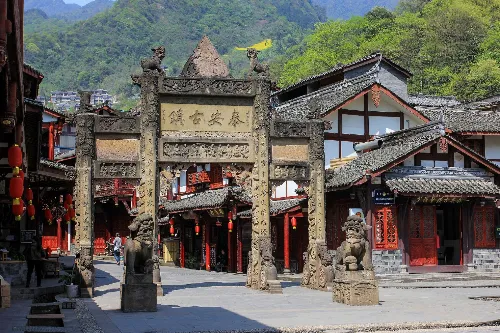
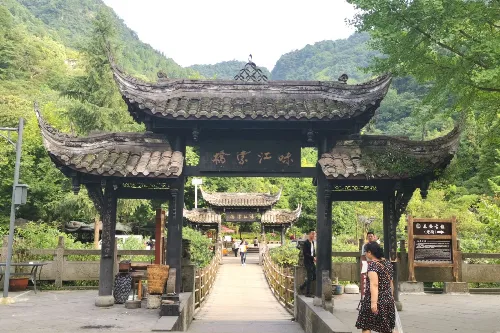

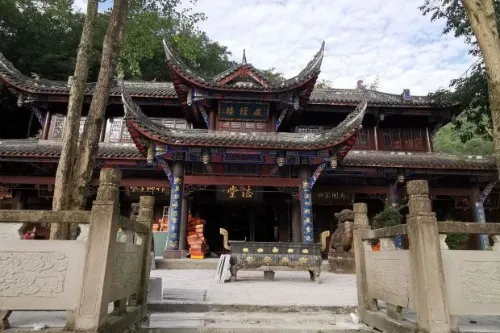
Wulong Gully
Wulong Gully is one of the main tourist areas in Qingcheng Back Mountain. It gets its name because five streams converge in the gully. Inside the gully, there are green mountains and clear waters, crisscrossing streams, and scenic spots such as Jinwawa Tuo (Golden Doll Pool), Longyin Gorge Plank Road, and White Dragon Spouting Water. Jinwawa Tuo is the core scenic spot of Wulong Gully. The pool water is crystal clear, and it is surrounded by green trees, making it a good place for summer resort.
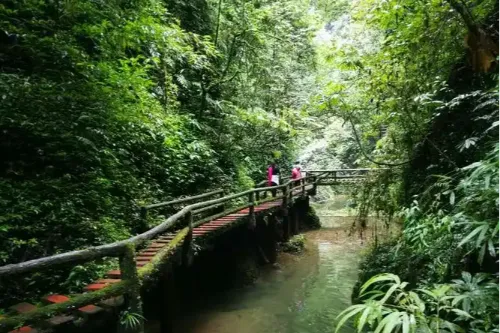
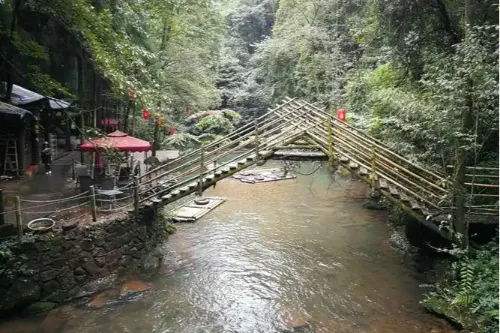

Longyin Gorge Plank Road
With a total length of about 600 meters, it is close to the steep cliff. Planks are laid in the air at the cliff section. In ancient times, wooden piles were inserted into the rocks to lay the planks, and now it has been reconstructed with reinforced concrete imitating wood, which is like a long dragon hiding in the gorge.


Feiquan Gully
Feiquan Gully is famous for its flying springs and waterfalls. There are many waterfalls in the gully, each with a different shape. Among them, the "Baizhang Long Bridge" (Hundred - Zhang Long Bridge) and the "Tianqiao Wonder" (Sky Bridge Wonder) are the most famous. The Baizhang Long Bridge is a stone arch bridge spanning Feiquan Gully, with a length of about 100 meters and a width of about 3 meters. It is one of the landmark buildings in Qingcheng Back Mountain. The Tianqiao Wonder is a naturally formed stone arch bridge, with a height of about 30 meters and a span of about 20 meters. The bridge deck is flat, just like a bridge in the sky.
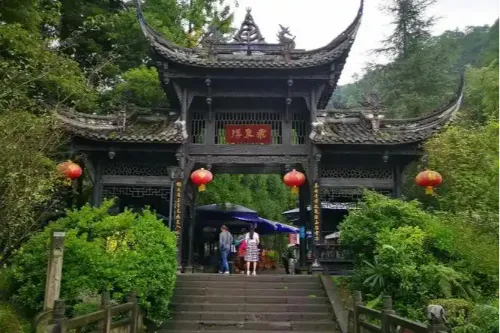

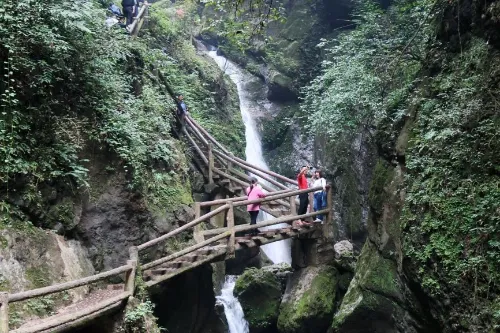
Baiyun Ten - Thousand Buddha Caves
It is located on the half - cliff of the watershed between Wulong Gully and Feiquan Gully. Stretching about 2.5 kilometers from north to south, it is scattered with hundreds of natural caves of different sizes, which were originally called Baiyun Caves. Among these caves, there are scenic spots such as Jiuseng Cave (Nine Monks Cave), Dizang Cave, Tongtian Cave, Dabei Hall, and Baiyun Temple, with 2,000 Buddha statues built inside, hence the name Baiyun Ten - Thousand Buddha Caves.
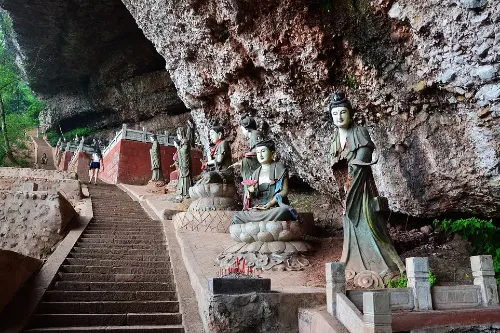
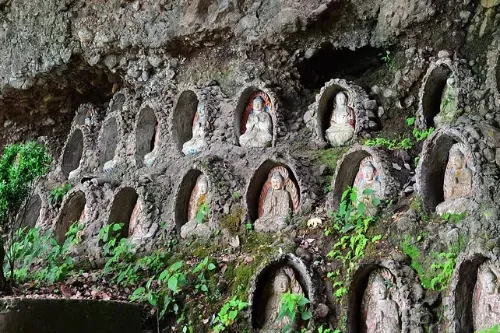
Baiyun Temple
As early as the Tang Dynasty, Monk Baiyun lived in seclusion here to practice Buddhism and attained enlightenment. Since then, this place has become a site for Buddhist scripture teaching and practice. Baiyun Temple was rebuilt on the ruins of Baiyun Nunnery in 1992 and was registered as a legal religious site open to the public in 1996.
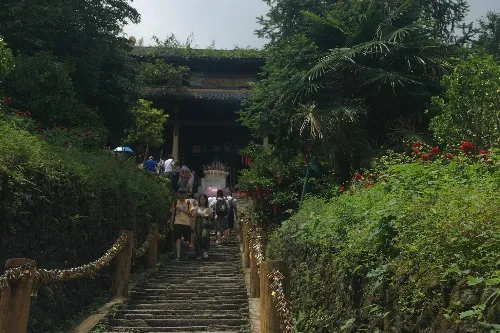
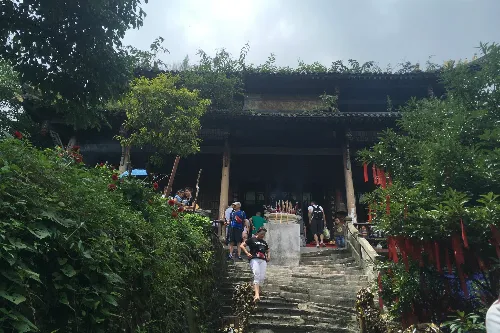
Tour Route
Recommended one - day tour route: Taian Ancient Town → Wulong Gully → Jinwawa Tuo → Longyin Gorge Plank Road → Youyicun (Another Village) → Baiyun Cableway → Baiyun Ten - Thousand Buddha Caves → Tianqiao Wonder → Feiquan Gully → Baizhang Long Bridge → Taian Ancient Town. This route covers the main scenic spots of Qingcheng Back Mountain and takes about 6 - 8 hours for the whole journey.
Travel Suggestions
- Wear comfortable shoes, as there are many mountain roads in the scenic area, and walking is relatively tiring.
- Take rain gear with you, as the weather in the mountainous area is changeable and it is easy to rain.
- It is recommended to set off early in the morning to avoid the peak tourist flow in the scenic area.
- You can taste local food and buy characteristic souvenirs in Taian Ancient Town.
- Tourists with poor physical strength can choose to take sightseeing buses and cableways to save energy.
Notes
- Smoking is prohibited in the scenic area, and attention should be paid to fire safety.
- Protect the environment and do not litter everywhere.
- Abide by the scenic area regulations and do not enter unopened areas without permission.
- Pay attention to weather changes. In case of bad weather such as heavy rain and strong wind, return to a safe area in time.
- There are many monkeys in the scenic area. Do not feed them casually to avoid being scratched by monkeys.
Transportation
- Bus: Take Metro Line 2 from Xipu Station in Chengdu to Xipu Station, transfer to the Chengdu - Dujiangyan Intercity Railway to Qingcheng Mountain Station, and then transfer to Bus No. 101 or No. 102 to Qingcheng Back Mountain Station.
- Self - driving: Start from Chengdu, take the Chengdu - Dujiangyan Expressway and the Dujiangyan - Wenchuan Expressway to the Qingcheng Mountain Exit, and then drive along the Qingcheng Back Mountain Tourist Highway to reach the destination.
- Chartered car: You can charter a car to go to Qingcheng Back Mountain near the urban area of Chengdu or the Qingcheng Mountain Scenic Area, with a cost of about 200 - 300 yuan per day.
Opening Hours
The opening hours are 08:00 - 17:00 (summer) and 08:30 - 17:00 (winter). The ticket sales time of the scenic area is 08:00 - 16:30 (summer) and 08:30 - 16:00 (winter). The actual opening hours of the scenic area shall prevail.
Tickets
The ticket price is 20 yuan per person.
You can search for the official WeChat public account "青城山都江堰" on WeChat to get the latest updates or buy tickets online.
Online Booking
Click here to jump to the Trip.com ticketing platform for ticket purchase.


